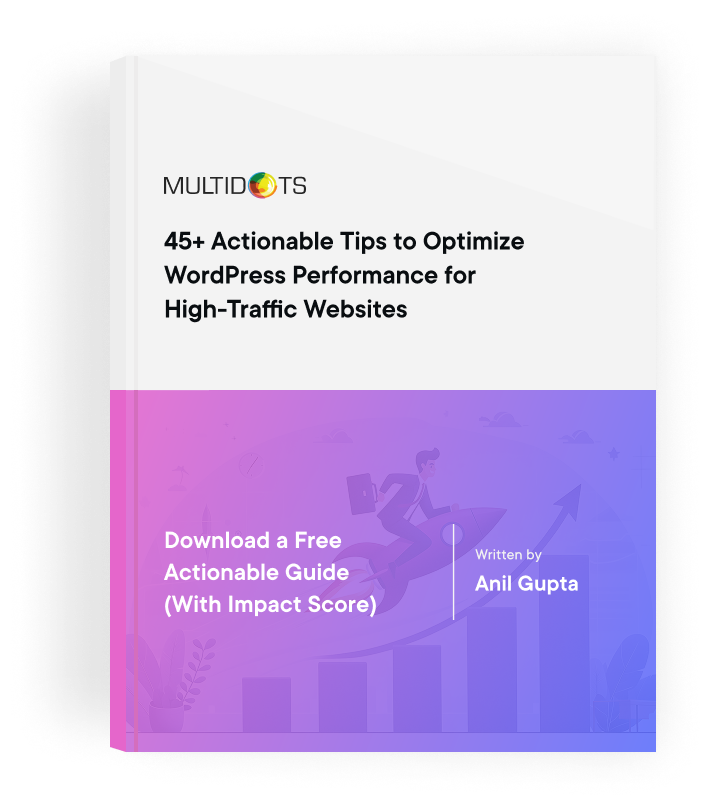15 Lesser-Known Strategies to Maximize Publisher Monetization
Discover key strategies to grow your revenue through effective publisher monetization in the AI era. Learn more!
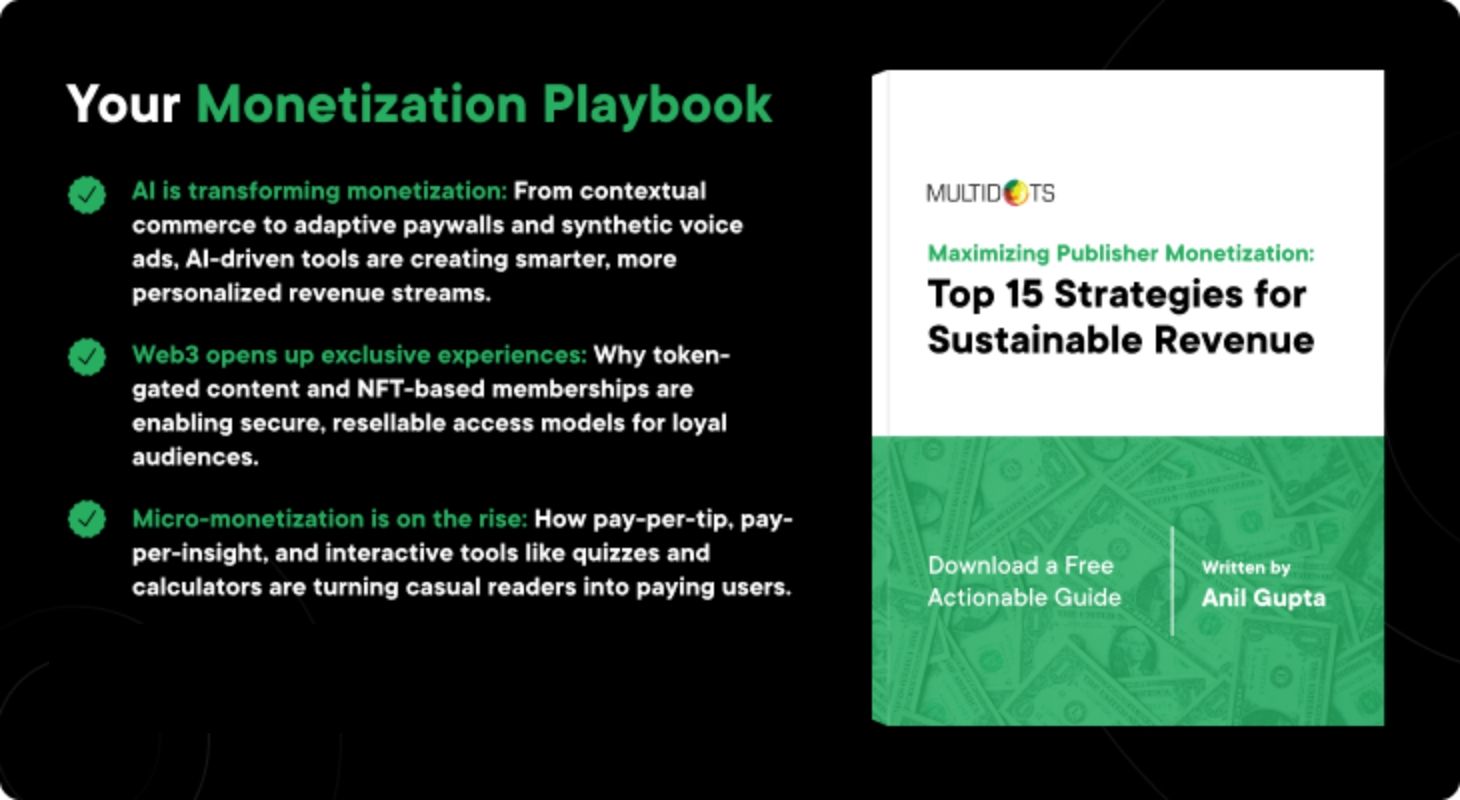
Table of Contents
Another year is upon us and, so too, is the need for digital publishers to up their game with their monetization strategies. As always, this means keeping abreast of the latest trends in the digital world, and there's certainly been no shortage of technological and other changes: from the rapid adoption of artificial intelligence (AI) and Web 3 tech to the diversification of subscription models, to name just a few.
So which developments should you focus on? As is often the case, there's no 'one size fits all' approach. Instead, effective publisher monetization requires a deep understanding of the digital advertising ecosystem, as well as the needs of advertisers. It also requires a sound understanding of your own audiences' needs.
To help you with this, we've listed the top 15 monetization strategies for publishers in 2025. But before we examine them, it'll be worth considering several factors that'll help you choose the right monetization strategy for your business.
Factors to Consider When Choosing a Monetization Strategy
Target Audience
Who are the members of your target audience? What are their specific needs and interests? Having clear answers to these questions will allow you to choose the right monetization strategy. For example, if international travel is both a key interest for your audience and related to your website's content, partnering with a popular chain of resorts may be the strategy your business needs. Or perhaps cautiousness is a key characteristic of your target market. If that's the case, freemium content or a pay-per-view pricing strategy may be the best way to engage with your prospective audience.
Whatever the case may be, knowing who your audience members are and giving them what they want as simply as possible will be critical to your success.
Business Objectives
Another key factor is your business's objectives. Ensuring that your monetization strategies are in lockstep with them will ensure that you minimize waste and maximize productivity.
Do your objectives, for instance, focus on customer retention? If so, ensuring that you incorporate appropriate AI tools when dealing with your customers could help you cultivate closer ties with them and, therefore, retain them.
Market Conditions
Businesses don't operate in a vaccum. Instead, the market is constantly changing, whether it's a new economic climate, changes to digital advertising regulations or, perhaps, the entry of new competitors. Whatever the challenges, keeping a finger on the pulse of your business's broader environment will help you select strategies that'll strengthen your business's footing.
Compliance and Privacy
As data becomes increasingly important in online publishing as well as the broader media landscape, so too does the ability to comply with the various data regulations. Chief among these are the European Union's General Data Protection Regulation (GDPR) and the California Consumer Privacy Act (CCPA) in the US. Even the most carefully prepared monetization strategy will, ultimately, fail if its execution violates relevant privacy regulations.
User Experience and Brand Integrity
Closely related to compliance with privacy regulations is the perception that your audience is likely to have of your business, based on your monetization strategy. If your strategy involves, for example, native advertising, how many ads will be used, and how will they be placed? Too many may slow down your website and, therefore, adversely affect the user experience your audience has of your site.
Other options may also affect their perception of your business. An over-reliance on affiliate marketing or clickbait ads, for instance, may erode the trust they have in your brand, as will excessive sponsored content. In short, whichever strategy, or mix of strategies, you eventually choose, always ensure that your audience's experience of your business is top of mind.
Top 15 Monetization for Publishers
Having clarified your audience's needs, your business's objectives and the broader market conditions, as well as the question of data privacy and how your business is perceived, you're now in prime position to capitalize on the top 15 monetization strategies in publishing.
1. AI-Driven Contextual Commerce
💡 What it is
Of all the latest AI applications in digital media, AI-driven contextual commerce offers, perhaps, one of the most exciting publisher monetization opportunities. This form of digital advertising embeds product recommendations, affiliate links, native commerce, and other digital ad space into content based on readers' behavior and the content's broader context.
📌 Example
The Streaming enables their editorial team to focus on creating quality content without needing to spend time finding contextually relevant products, and optimizing product links to maximize the higher partner return, with the use of AI Shopping Galleries.

AI Shopping Galleries
🔧 Tools
GumGum, StackCommerce, Tipser, Skimlinks, Sovrn AI shopping galleries, Taboola Commerce
2. Web3 Subscription Models (NFT-Based Memberships and Token-Gated Content)
💡 What it is
Web 3 technologies have steadily been gaining traction in recent years, and the trend is set to continue in 2025, especially with digital publishers. Their appeal in publishing lies primarily with blockchain technology, given its ability to afford secure content distribution and protect intellectual property.
Non Fungible Token (NFT)-based memberships and token-gated content, standard features of Web3 subscription models, constitute another increasingly popular publisher monetization strategy. With this option, publishers create NFT-based subscriptions in which holders are given exclusive content, Discord access, or premium reports with resale capabilities.
📌 Example
CryptoSlate is only an informational website that provides news about coins, blockchain companies, blockchain products and blockchain events, offers a deep research membership only NFT product, where access is only provided in exchange for Solana coin tokens.
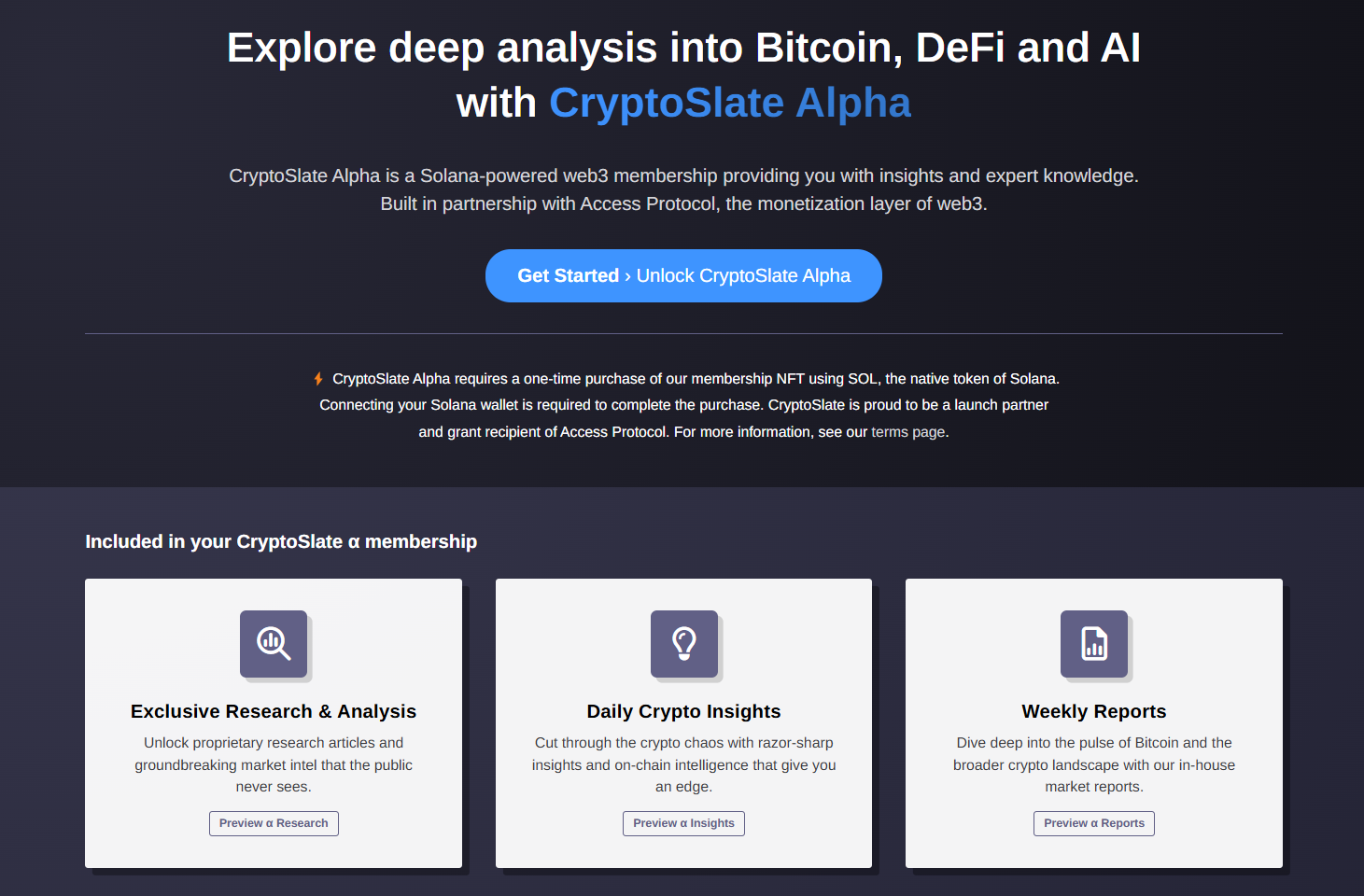
CryptoSlate
🔧 Tools
Unlock Protocol, Mirror.xyz, Manifold.xyz, Zora, Access Protocol
3. Micro-Monetization via Pay-Per-Interaction and Tipping
💡 What it is
One of the more affordable monetization solutions, micro-monetization gains its appeal from its ability to slowly entice potential subscribers into signing up for full subscriptions. It achieves this by offering potential subscribers the option of paying small amounts for specific article sections, highlights, or insights. By starting slowly with potential subscribers, publishers can lay the foundation for a relationship that should enhance their capacity to generate revenue in the long-term, provided that their initial offering is successful.
📌 Example
Dylane Moreau provides French tutorials through The Perfect French with Dylane. She uses the Support My Work and Donate buttons throughout her website to encourage incremental revenue for her free content.
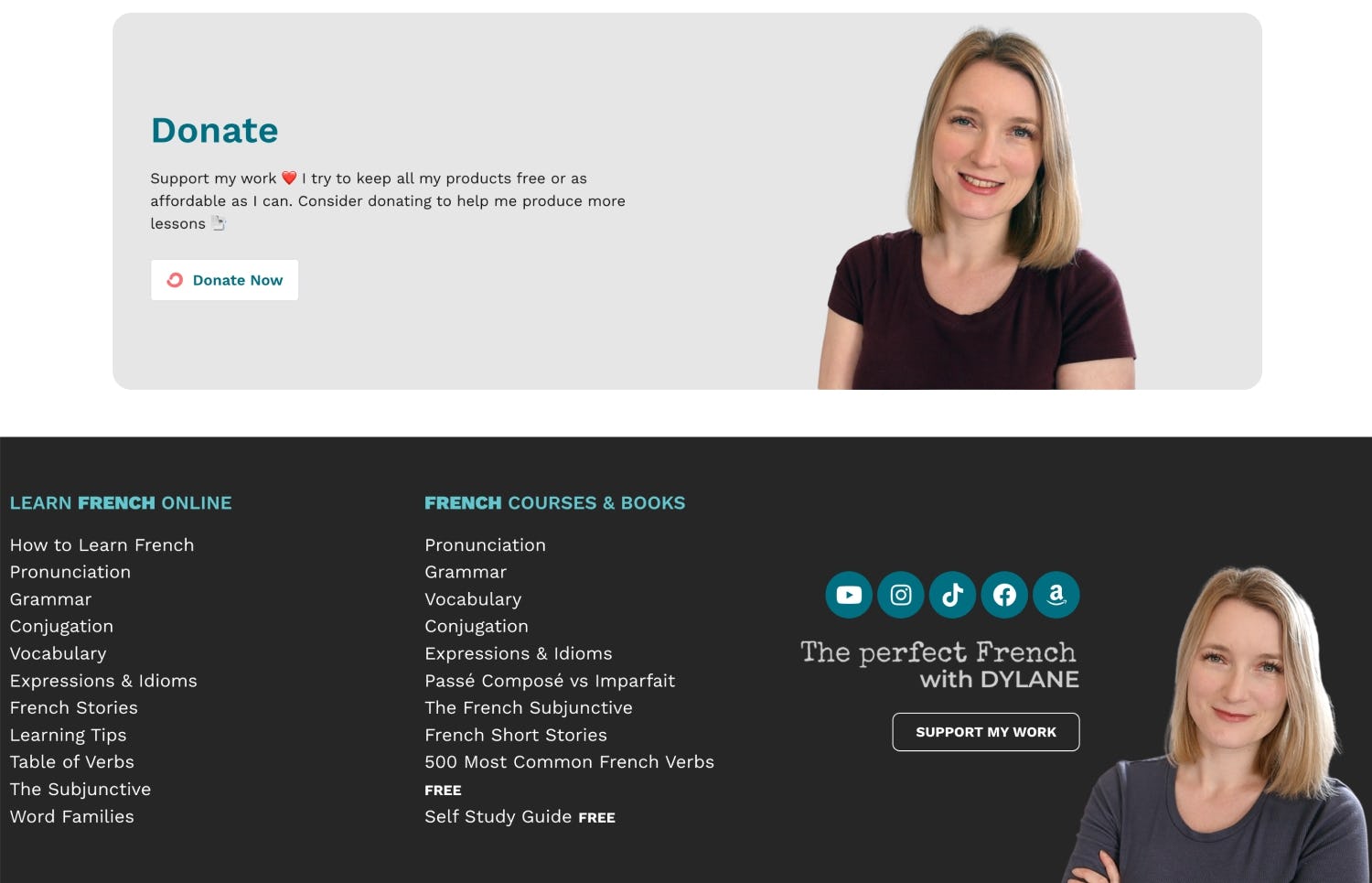
The Perfect French with Dylane
🔧 Tools
Nichely, Coil, Kive, Buy Me a Coffee, Ko-fi, Tip.cc, Kit
4. AI-Powered Ad Inventory Optimization for Yield Maximization
💡 What it is
A tried and trusted ad monetization solution, this strategy offers targeted advertising by placing ads in optimal locations, based on a website visitor's scroll patterns, engagement, and viewability. Because of this, it's ideal for increasing RPM (Revenue Per Mille), a key ad monetization metric. As a way to optimize ad placements, it's been applied by publishers in various industries, confirming its nature as a practical way for publishers to generate revenue.
📌 Example
A news site sees an increase in ad revenue after implementing AI-driven rules based auto-optimization.
🔧 Tools
Ezoic, PubGuru, MonetizeMore, AdThrive, Google Ad Manager
5. Live Commerce and Shoppable Video Embeds
💡 What it is
Embedding live audiovisual content on their website is another strategy that can enable publishers to generate revenue streams. This strategy involves publishers integrating interactive shopping experiences within video and editorial content, enabling one-click purchases.
📌 Example
Narcity transformed the reader experience into a powerful video-powered 'story' experience. resulting in a 48X increase in video plays, and a 52% uptick in average time-spent on the site.

Narcity
🔧 Tools
Firework, Livescale, Bambuser, Shoploop (by Google)
6. Sponsored UI Elements and Ad-Integrated Search Bars
💡 What it is
Online advertising doesn't just involve standard display ads, such as banner ads, or more sophisticated ad forms, such native advertising. Nor does it hinge solely on programmatic advertising. Often, the simplest way for many publishers to monetize their content is to use the UI elements on their website or app as vehicles for ad content. In its most common form, such content monetization involves monetizing elements such as navigation bars, search fields, and menus with branded placements.
📌 Example
Site search and chatbot tools like Front Office Sports have been incorporated to increase time on site, content consumption, and revenue.
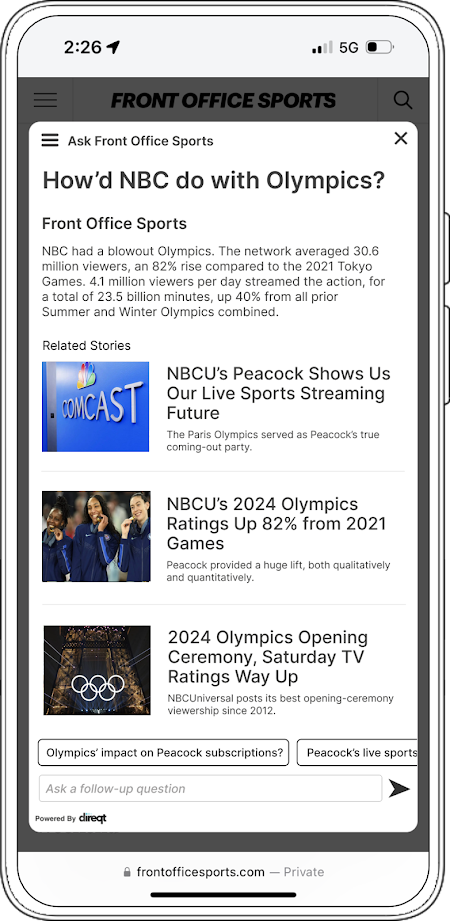
Front Office Sports
🔧 Tools
Direqt, Monetate, SearchSpring, Algolia
7. AI-Generated Synthetic Voices for Audio Monetization
💡 What it is
In an effort to make their high quality content accessible to more audiences, modern publishers are employing AI to provide audio versions of their content. In its most popular form, publishing such online content involves AI narrating articles, allowing users to listento content instead of reading. The content is monetized via premium subscriptions or ads.
📌 Example
AI-read audio versions of news to all readers. Such marketplaces can also help talent to license their voice and get royalties for their content.

The Stanford Daily
🔧 Tools
Narrativ, Ad Auris WellSaid Labs, Play.ht, Resemble AI, BeyondWords
8. Personalized Newsletters with Dynamic Paywall Tiers
💡 What it is
With their capacity to differentiate content in a fiercely competitive market, paywalls are becoming a fundamental part of the monetization strategies for most publishers. According to a recent report by the data analytics company Piano, publishers who set up a paywall registered, on average, a 35% increase in subscription conversion rates compared to publishers using other subscription models.
But paywalls are just one part of a broader strategy. Equally important is the personalization of content. Any news publisher wishing to develop their revenue streams should consider personalizing their communications with their audiences. The most effective forms of such personalization, when combined with paywalls, involve AI segmenting audiences and dynamically adjusting newsletter pricing and content based on reader engagement.
📌 Example
ELLE Magazine France implemented a strategy where the heading and highlighted subscription benefits were adapted based on the newsletter from which a reader visited the site. This personalization led to increased reader engagement and higher conversion rates, demonstrating the effectiveness of combining personalized newsletters with dynamic paywall strategies.
🔧 Tools
Beehiiv, Substack, ConvertKit, LiveIntent
9. First-Party Data Monetization via Identity Solutions
Instead of relying on third-party cookies, publishers share aggregated audience insights with advertisers via secure data partnerships.
📌 Example
Pop culture publisher Ranker collected first-party data using on-site voting systems, surveys, and behavior analytics tools to build user identities. By utilizing a Customer Data Platform (CDP), Ranker created high-intent audiences for various advertising campaigns, leading to a fourfold revenue increase year-over-year and a 25% win rate in Request for Proposals (RFPs).
🔧 Tools
Google Ads Data Hub, InfoSum, Snowflake, Permutive, Xenoss
10. API Monetization and Embedded Data Licensing
💡 What it is
Publishers sell access to proprietary data (e.g. stock trends, sports stats, financial reports) through APIs.
📌 Example
An investment management firm utilized FactSet's Publisher API to streamline the creation of client-facing reports. By integrating the API, Loomis Sayles automated the generation of customized, presentation-ready documents that incorporated portfolio analysis, risk assessments, and proprietary data. This automation reduced manual processes, enhanced efficiency, and ensured consistency in reporting.
🔧 Tools
RapidAPI, AWS API Gateway, GraphQL, Postman
11. AI-Powered Paywalls with Adaptive Pricing
💡 What it is
A popular form of content monetization is AI-powered adaptive pricing. With this strategy, instead of a one-size-fits-all subscription model, AI is used to adjust paywall pricing based on the behavior, location, and engagement ofusers on a website.
📌 Example
Bangor Daily News transitioned from a static paywall to Sophi's dynamic, AI-powered user paywall engine. This system makes real-time, data-driven decisions based on user engagement, determining whether to present a subscription offer or grant open access. Since implementation, BDN has achieved a 47% increase in direct paywall subscriptions and a 2.3x improvement in conversion rates, all while maintaining audience engagement and advertising revenue.
🔧 Tools
Piano, Poool, Zephr, LaterPay, Sophi
12. Programmatic Native Ads with AI Personalization
💡 What it is
On their own, both programmatic advertising and native advertising can be effective strategies for maximizing revenue. But when combined properly, they can become a particularly effective form of content monetization. Thanks to AI, this strategy involves AI dynamically matching branded content with audience interests, delivering native ads in a seamless experience.
📌 Example
Publishers like CNN and The Guardian integrated Smartfeed into their platforms and observed a 25% increase in user engagement. The personalized ad recommendations led to higher click-through rates and improved overall user satisfaction.
🔧 Tools
Outbrain, Taboola, Nativo, Revcontent
13. AI-Powered Chatbots for Lead Generation and Upsells
💡 What it is
By employing AI, tailoring the user experience on a website can be achieved in myriad ways. Perhaps one of the most engaging ways is through chatbots, which can foster the development of new revenue streams for publishers. The most common way in which this is realised is by chatbots offering personalized content recommendations, paywall teasers, and affiliate promotions.
📌 Example
A chatbot suggesting premium reports or high-ticket affiliate investment courses based on user queries.
🔧 Tools
Drift, Intercom, ManyChat, Chatfuel
14. Interactive Quizzes and Paid Assessments
💡 What it is
Given that your audience's needs should be the ultimate focus of all of your monetization solutions, it's handy, then, to know as much about them as you can. And one of the best ways to deepen your knowledge of their needs - and develop new revenue streams - is to offer them interactive quizzes and paid assessments. For publishers, such content usually takes the form of in-depth personality tests, business assessments, or skill evaluations.
📌 Example
A business publication offers a paid "Entrepreneur Readiness Score" for users, generating leads for coaching services.
🔧 Tools
Quizzly, Outgrow, Typeform, Quizizz, LeadQuizzes
15. Embedded Affiliate-Driven Calculators and Tools
💡 What it is
Finally, publishers can strengthen and expand their revenue streams by offering calculators and other similar tools on their websites. Interactive calculators can generate affiliate commissions for publishers by driving users to related services.
📌 Example
NerdWallet provides investment return calculators that help users project potential earnings. Post-calculation, users receive suggestions for investment services through affiliate links.
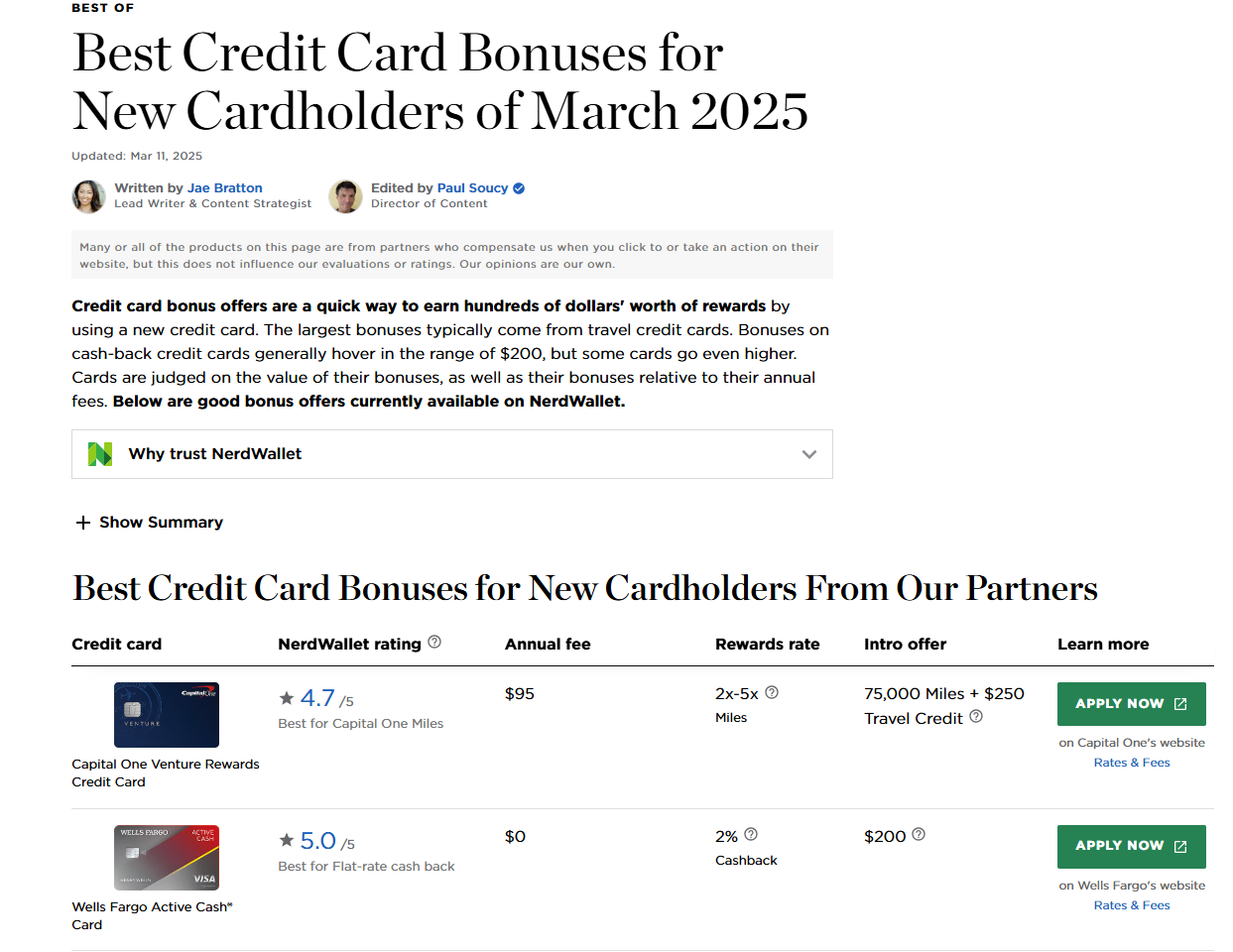
NerdWallet
🔧 Tools
CalcBuilder, ConvertCalculator, MortgageHippo, FunnelFlux
Final Thoughts
Whether you're an established publisher with an extensive audience or perhaps a newcomer who's keen to gain a foothold, keeping abreast of the latest monetization solutions is critical.
In this article, we've examined some of the more prominent strategies that are likely to resonate with publishers and their audiences over the coming year and beyond. Regardless of the nature of your publication or the size of your audience, it's highly likely that at least one of them, if not several, will, at some point, play a key role in your business. For a snapshot of these strategies to help you determine which ones might be best for your business, just download this checklist.
Whichever strategies you choose, listening closely to the needs of advertisers and audiences will certainly help you take your business in the right direction. And to help you on your journey, we're always at hand. We've helped many publishers manage their platforms and maximize their growth. To help you implement these strategies, contact us today.
Discover innovative ways to boost revenue without compromising user experience.
Contact Us